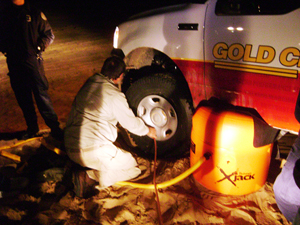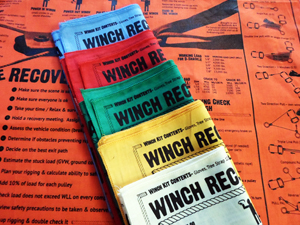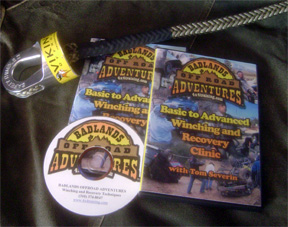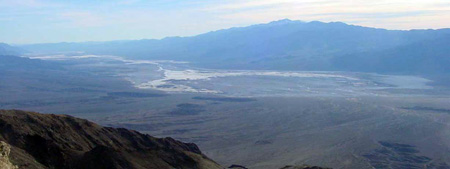Do you Know Jack?
 Before jacking, make sure that the vehicle cannot move.
Before jacking, make sure that the vehicle cannot move.
(Click picture for a larger image.)
|
A jack is one of those pieces of equipment that is just plain essential for four wheeling. The stock jack supplied by the manufacturer isn’t going to help off road: terrain is rarely level and never smooth. You have three styles to choose from: Hi-Lift, X-Jack and bottle jack.
The first step in any situation is to make sure the vehicle cannot move.
Sometimes the emergency brake isn’t enough, because you might be lifting that wheel.
You might have to chock the opposite side. Seldom is the terrain flat and level. Run the winch out to a tree or stretch a strap tightly from the vehicle to be jacked.
Always be careful when jacking.
Hi-Lift Jack
The Hi-Lift is very versatile but has a lot of safety risks.
It is versatile in the sense you can lift (jack) with it, you can “pole vault” with it, and you can use it as a “poor man’s” winch in a pinch.
Lift as close as possible to the tire you want to get off the ground. If you lift in the middle of either bumper, the vehicle is likely to tip in one direction.
Vehicles today don’t have notches in the frame for a jack. So latch onto the bumper as close to the affected wheel.
The base on a Hi-Lift jack is pretty small. That makes it challenging to lift on uneven surfaces. You may want to purchase a safety kit.
That includes an extra-wide base and support cables.
“Pole vaulting” involves shifting a vehicle sideways while jacked up. Let’s say you’re stuck and just need to move a foot or two to one side. Set the jack near the middle of the opposite side, at a slight angle. Once both wheels on the near (jack) side are off the ground, the vehicle will fall away. Repeat as needed to move away from the obstruction.
With a chain on one end and a tree strap on the other, the Hi-Lift can be used as "poor man's" winch by laying it sideways.
The chain allows you to adjust the distance from the vehicle to your anchor point.
Since you can only move the stuck vehicle about 3 feet at a time the chain makes it easier to reset the jack each time.
By looping the chain around the "nose" of the jack, you can shorten it with a grab hook.
Besides all the hard work, the difficulty is keeping the vehicle in place every time you reset for a new bite.
Hi-Lift recovery kit has all the gear your need to solve this problem.
You need to be careful with Hi-Lifts. Use only on solid ground and when the main part is straight up and down.
If you must jack on sand or soft soil, place a piece of plywood or other board under the foot.
Make sure the handle is straight up when at rest. When lowering a vehicle, place a hand at the top of the center piece and gently coax the lever up and down.
Keep your fingers on top and clear; if the lever takes off, you’ll get “hammer thumb.” Keep your head out of the way, as well for the same reason.
A basic Hi-lift runs about $70. They’re rated to nearly 5000 lbs. for the first 4 feet. With safety accessories, you’re looking at about $230.
Though there are safety issues, the Hi-Lift jack is an extremely versatile and useful tool. Don't leave home without one in the group.
X-Jack
The X-jack is really helpful in sand and snow. You slide it under the vehicle, and use exhaust to inflate the bag and raise the vehicle.
Watch for sharp edges of the body or frame, and keep the bag away from the exhaust pipe. It’s a good idea to place padding on top of the bag.
(See Figure N.) The X-Jack comes with a pad, but I suggest grabbing one or two floor mats for additional padding.
Make sure there are no kinks in the hose as you’re playing it out.
The X-Jack works best with two people: one to hold the funnel tightly on the exhaust pipe and the other to keep the bag in position.
If working alone, use a compressor. The bag also has a valve stem to attach a compressor so you can tap into that while positioning the bag.
Be careful if lifting on sand. We tend to use high RPM in the sand.
This causes a hotter exhaust, and it’s easier to melt the hose.
If you have a compressor, use that instead. You may find that the bag quits inflating the last foot or so.
It is necessary to run the engine at a higher RPM (than idle) to fully inflate the bag. Another reason to have help.
A drawback is that the kit takes up a fair amount of space in the vehicle. Consider tying it on the outside or roof if space is a premium.
Bottle jack
Compact and more stable than the Hi-Lift, a bottle jack allows you to lift just an axle as opposed to an entire side of the vehicle.
A big disadvantage is that you don’t always have sufficient clearance under the vehicle (use the Hi-lift or X- jack).
The second downside is that it won’t always lift high enough for what you need. The post usually extends only about 5- 6 inches.
That’s why you may want to buy extensions. If you don’t care to do that, try a block of wood.
The
Safe Jack Company has a number of extensions available for the bottle jack.
If you have a vehicle close to 10,000 GVWR (like a Sportsmobile), Safe Jack has 5 ton accessories.
Bottle jacks come in a variety of sizes. A 3-ton model is sufficient for most 4WD use.
For larger vehicles like a Sportsmobiles, a 5-ton jack is better. I’ve seen good results with electric models.
A standard bottle jack runs $40 to $60 at auto parts stores.
Regardless of the style of jack you have, you must always use it safely.
Before jacking, make sure that the vehicle cannot move.
Use the jack properly, and—in the case of the Hi-Lift—keep your hands and fingers (and even body) out of harm’s way.
Be patient. Sometimes you need to think through the lift process to avoid serious injury. Learn the proper way to use the jack, and practice back home to become familiar with it.
Finally, if you must work under the vehicle while it’s raised, use your spare tire or other sturdy object as a safety jack.
I recommend you carry at least 2 of the above!
##########################
Related Articles from Badlands Off-road Adventures
|
Did you miss the previous article?
Upcoming Events
(click on the link for details)

Mojave Lower Desert, CA
(Click picture for a larger image.)
|
Summary of upcoming events.
The 2016 schedule of events (as we know it today) has been populated on the web site. Since we are planning these events anywhere from 5 months to 17 months in
advance, there are times when we have to make some adjustments.
New for 2016 is a
Women-Only Getting Started Clinic in Feburary.
We are bring back The
Wilderness First Aid Clinic (WFA).
This a 2 days class that will be held at Hungry Valley SVRA.
You will notice we are kicking off our back to the desert season with a
Getting Started Off-Road Driving Class in Borrego Springs on October 17th.
We will have monthly clinics in Borrego Springs until April next year.
Check out the OAUSA Borrego Fest weekend. Look at their website
for details.
October is a great time for an adventure to
Death Valley. We have scheduled a 4 day trip for Oct 23 - 26.
And it is not too early to sign up for the
Tonopah and Tidewater Railroad Adventure just after Thanksgiving.
In early November, We will be attending SEMA again this year in Vegas.
|
##########################
Death Valley October 23 - 26, 2015
This is a 4 day trip on the back roads in Death Valley.
We will drive the Panamint Mountains, drive past Badwater Basin (lowest spot in North America),
visit Chloride Ghost town, Titus Canyon, check out Ubehebe Crater, Teakettle junction, The Race Track & Lippencott Mine Road,
camp at the Warm Springs and leave via Steal Pass up to the high meadows, then take Dedeckera Canyon
down to the Eureka Sand Dunes. All four days will see some light to moderate 4-wheeling.
Much of the trip is quite remote with random or no cell service. We don't plan to stop at tourist sights you can get to in a passenger car.
Check out the details and sign up on the website:
http://www.4x4training.com/Adventures/Deathvalley.html
August 2013 Off-Road Adventures Magazine: Death Valley Excursion by Denis Snow
You can register directly at
http://www.4x4training.com/calendar/calendar.php#Deathvalley
|
Winch Recovery Bandana & Winching DVD

Click for higher resolution image
|
We have our new stock with many new colors (Red, Orange, Green, and Blue) on hand.
The Bandana is packed full of useful information and is a quick reference in the field when no DVD player is available."
The Bandana layout follows the “Vehicle Recovery Plan” with pathways to more detail.
A unique section of the Bandana, gives the steps for a “Winch Rigging Check: Walk through” so that you verify every element of the rigging before you commit to the pull.
Stuff this in your recovery kit and you will always be ready!
Pick up or order the Winching DVD too!
There is no substitute for hands on training. If you can, sign up for one of Badlands Off-Road Adventure’s Winching Clinics.
Warning – the Bandana and DVD are not a substitute for proper training and use of quality equipment that is used within the bounds of their safe working load.
We advise you to use the information provided in both the Winching Recovery Bandana and the "Basic to Advanced Winching and Recovery DVD" at your own risk.
We cannot control the quality and specifications of the equipment used and the methods actually employed.
|
Winch Recovery Bandana Order Button
|
Order a Basic to Advanced Winching & Recovery DVD too!

(Click picture for more details)
|
|
I hope to see you on the trails!
Tom Severin, President
Badlands Off Road Adventures, Inc.
4-Wheel Drive School
310-613-5473
http://www.4x4training.com
Make it Fun. Keep it Safe.
If you find this information valuable, please pass it on to a friend. You can forward them the email.
If you received a forwarded copy of this newsletter and would like to subscribe for yourself, go to:
www.4x4training.com/contacts.html
and follow the instructions to join our mail list.
Want To Use This Article In Your Magazine, E-Zine, Club Newsletter Or Web Site?
You are welcome to use it anytime, just be sure to include the following author/copyright information:
Tom Severin, 4x4 Coach, teaches 4WD owners how to confidently and safely use their vehicles to the fullest extent in difficult
terrain and adverse driving conditions.
Visit www.4x4training.com to develop or improve your driving skill.
Copyright 2015, Badlands Off-Road Adventures, Inc.
|
|
 Before jacking, make sure that the vehicle cannot move.
Before jacking, make sure that the vehicle cannot move. 


